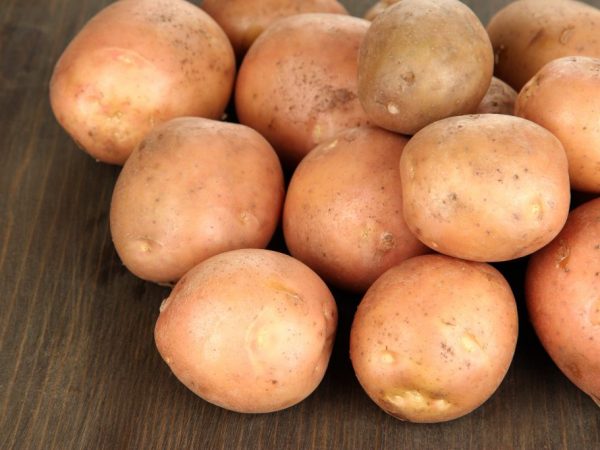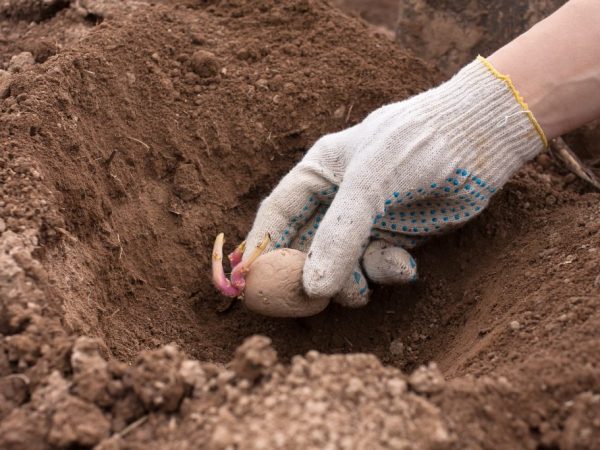Characteristics of the Irbitsky potato variety
For gardeners of the Volgo-Vyatka, Uralsky regions and Western Siberia, Irbitsky potatoes will be a good purchase. This is one of the new varieties of Russian selection, which allows you to collect a sufficient harvest from a small summer cottage to provide a family with reserves for the winter.

Characteristics of the Irbitsky potato variety
Irbit potatoes passed state registration in 2012, it is recommended for growing in areas with a temperate continental climate.
Description
The variety is medium early in terms of ripening. 65-80 days pass from germination to technical ripeness. The description of the Irbitsky potato variety was given by its originator - the Ural Research Institute of Agriculture. Semi-upright bush, medium size, intermediate type (between compact and spreading). The tops are dark green in color.
A medium-sized leaf, moderately dissected, forms large inflorescences with corollas of red-violet color. Tubers are round, red, weighing 110-180 g. Usually 6-8 tubers with a total weight of up to 2 or more kilograms are formed under the bush. The skin is thin, smooth, with small eyes. The pulp is light yellow. The potato has good taste, medium digestibility. Starch content - 12-16%.
Advantages and disadvantages of the variety
The Irbitsky variety has a number of characteristics, thanks to which summer residents acquire for breeding its planting material of the super-elite class:
- Adaptability to agro-climatic conditions. According to the State Register, the culture is recommended for 3 regions of the Russian Federation, but it is successfully grown in other territories of the Russian Federation and abroad.
- High yield: from 1 hectare harvested from 255 to 390 centners, the maximum figure is 468 centners.
- Possibility of long-term storage.
- Widespread use in cooking.
- Moderate resistance to many diseases: potato cancer, different types of mosaics, viruses X, Y, L, S, nematode.
According to the description, the variety has no particular drawbacks. Like any other variety of potatoes, this one shows large yields under a number of conditions.
Planting potatoes
One of the necessary requirements is high-quality planting material. It is better if it is a super elite or an elite, i.e. tubers that have all varietal qualities and have not accumulated disease. The preparation takes place traditionally. They take care of the soil since autumn.
Soil preparation
A well-lit area is allocated for growing crops. The most acceptable soil characteristic for the Irbitsky potato variety is as follows: loose, fertile, slightly acidic, although the variety will grow on any soil. It is not recommended to grow a culture in one place for more than 2-3 years, after other representatives of the nightshade family, to place beds next to plantings of tomatoes, eggplants, bell peppers. The best precursors for potatoes are legumes, perennial herbs.
Fertilizers are applied to the soil during autumn digging or in spring, immediately before planting potatoes.
The plant needs both organic and inorganic fertilizers. The minimum set is humus, wood ash, nitrophoska. The dosage depends on the characteristics of the soil, If the soil is clayey, heavy, per 1 sq. m consume a bucket of humus or peat, 1 tbsp. wood ash, 2 tbsp. l. nitrophosphate. Sandy soils need regular fertilization to improve structure, water retention and fertility.
Planting potatoes
Before planting, seed potatoes are prepared. The sequence of actions is as follows:
- 3-4 weeks before planting, damaged tubers are selected, transferred from storage sites to a warm, bright room for germination and greening (it is better to decompose in 1-2 layers);
- after the sprouts have reached 2-3 cm, calibration is carried out;
- immediately before planting in the soil, large potatoes are cut into several parts so that each one has 2-3 sprouts;
- the planting material is treated with a composition including insecticides (if there is a threat of pest damage) and growth stimulants, a solution of potassium permanganate is used.

Only healthy tubers are suitable for planting.
Tubers are recommended to be planted after the soil has warmed up to a temperature of 5-8 ° C to a depth of 10 cm. Failure to comply with the terms leads to a delay in development and a significant decrease in yield (up to 20%).
Irbit potatoes are embedded in holes located 60 cm from one another. The distance in the row is 35 cm, the depth is 8-10 cm. If the site has not been fertilized earlier, you can add humus and ash directly to the hole. In no case should unripe manure be used.
Potato care
The variety is unpretentious in care. It is enough to follow the simple rules common to a given culture.
Watering
The variety tolerates drought well, but needs watering during the period of budding, flowering and tuberization. The first watering is carried out after the emergence of shoots. If there is no rain in July, early August, and the land dries up, it is imperative to lower the soil temperature and extend the growing season with abundant watering, but the moisture on the site should not stagnate.
Watering is carried out after hilling and combined with fertilization. The formation of a crust must not be allowed, the soil must be loosened, weeds are destroyed.
A special procedure that any potato variety needs is hilling. It is carried out at least 2 times a season to create conditions for tying tubers, better aeration. The first time they huddle when the plants stretch up to 15 cm. At the same time, a high earthen ridge is poured - up to 20 cm. The next hilling is carried out before closing the tops.
Fertilizer
Like all varieties of medium ripening periods, Irbitsky potatoes especially need nutrients during the period of intensive growth of tops and the beginning of tuberization. It is necessary to maintain a balance of nitrogen, phosphorus and potassium fertilizers. The predominance of nitrogen will lead to a rapid increase in green mass and a decrease in the quantity and quality of the crop.
The first feeding is carried out after the first hilling. For this, a liquid mixture of inorganic fertilizers is used. In one bucket of water they dilute:
- 30 g of nitrogen fertilizers;
- 30 g of potash;
- 60 g phosphoric.
It is advisable to feed with organic fertilizers. Chicken droppings are effective. It cannot be used fresh. Gardeners usually prepare a slurry: they dilute the droppings in water in a ratio of 1:15 and leave them to ferment in a closed container for several days. The norms for using such top dressing are no more than 1 liter per bush.
You need to fertilize the plant after watering, pouring fertilizers into the holes. Do not allow these nutrient mixtures to come into contact with the tops.
Foliar dressing is effective for the culture, especially at the stage of growing green mass, during flowering and tuber formation. For plant nutrition, urea (for 5 liters of water 100 g of carbamide, 150 g of potassium monophosphate, 5 g of boric acid) and phosphoric (for 10 liters of water 100 g of superphosphate) fertilizers are used.
You can feed on the leaf and organic fertilizers. For this, solutions of humates, nettle infusion, rich in trace elements, are used. To prepare such an infusion, the nettle is poured with water, left to ferment, then filtered, diluted with water. Such foliar dressing can be carried out after the formation of 4 true leaves with an interval of 10-14 days.
Pest control
Since the variety is resistant to most diseases, pests are the main threat to the crop. The most dangerous pest, especially in the southern regions, is the Colorado potato beetle. To combat it, mechanical (collection of larvae and adult beetles) and chemical methods are used. In specialized retail outlets, they purchase effective insecticides and biological products (Aktara, Bankol, Bicol, Regent, Colorado, etc.). If the number of larvae is small, you can use self-prepared herbal preparations. It can be daily infusions of wormwood, walnut leaves, celandine or decoctions of dandelions, hot pepper.
To prevent damage to tubers by wireworm, the introduction of Bazudin granules during spring soil preparation will help. To destroy the bear, which damages young tubers and gnaws stolons, it is necessary to add Vofatox or Medvetox to the soil to a depth of 2-3 cm.
Conclusion
In late July - early August, you can already dig up young potatoes. But if you are aiming at harvesting the maximum yield, you need to wait until the tubers are fully ripe.
To increase yields among summer residents and gardeners, mowing of the tops is practiced 10-14 days before harvesting. It can be composted and used as a valuable fertilizer. Extracts from fresh or dried tops are a preparation for combating many pests of the garden and vegetable garden.


